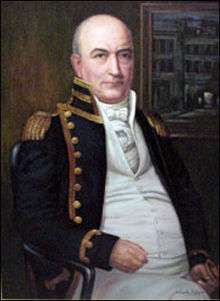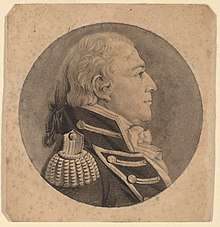Thomas Tingey
Thomas Tingey (11 September 1750 – 23 February 1829) was a commodore of the United States Navy. Originally serving in the British Royal Navy, Tingey later served in the Continental Navy. Tingey served with distinction during the Quasi-War and served as the commandant of the navy yard until his death.
Commodore Thomas Tingey | |
|---|---|
 Commodore Tingey in uniform | |
| Born | 11 September 1750 |
| Died | 23 February 1829 (aged 78) |
| Resting place | Congressional Cemetery |
| Nationality | American |
Biography
Early life
Tingey was born in London on 11 September 1750. As a youth, he served in the British Royal Navy as a midshipman aboard HMS Panther and later in July 1771 commanded a blockhouse at Chateaux Bay on the Labrador coast. He later commanded merchant vessels in the West Indies before coming to the colonies and investing in the East India Company. According to unverified tradition, Tingey served in the Continental Navy during the American War for Independence.[1]
Navy career
In September 1798 Tingey was commissioned a captain in the United States Navy and distinguished himself in the Quasi War with France, as commander of the man-of-war Ganges. During that time, Tingey commanded a squadron which cruised the waters of the Windward Passage between Hispaniola and Cuba to protect American shipping from French privateers. Tingey commanded Ganges as she took four prizes and is known for his bloodless encounter with the British frigate HMS Surprise. He was discharged from the Navy following the conclusion of the Quasi War in 1802.
Washington Navy Yard
In January 1800, Tingey was appointed to supervise construction of the new Washington Navy Yard at Washington, D.C.. He was well connected in Washington D.C. political circles and had close relations with members of Thomas Jefferson and James Madison's cabinet. On 23 November 1804, he was again commissioned a captain in the Navy and made Commandant of the Washington Navy Yard and naval agent, posts he held until his death.

As naval agent in accordance with the naval regulations of the era, Commodore Tingey received 1% of his Washington Navy Yard disbursements as commission. His involvement in procurement and contracting issues soon gave rise to a perception of irregular purchase and an inquiry into these charges on 10 December 1810 Secretary of the Navy Robert Smith establishing inquiry into the Commodore's conduct. The inquiry failed to find any substantive violations.[2]
During Tingey's tenure as commandant, Washington Navy Yard personnel were frequently used design and test new weapons. Secretary Smith requested Tingey on 6 February and 17 August 1808 arrange a test of Doctor Wallace's invention and Robert Fulton's torpedo both projects which required yard employees and resources.[3]
In August 1814, as the British advanced on Washington, the Secretary of the Navy ordered Tingey to set fire to the yard. He wrote to his daughter under date of 17 September 1814, "I was the last officer who quitted the city after the enemy had possession of it, having fully performed all orders received, in which was included that myself retiring, and not to fall into their possession. I was also the first who returned and the only one who ventured in on the day on which they were peaceably masters of it."[4] Tingey resumed his duties as commandant after the withdrawal of the British forces.
Throughout his twenty-nine year tenure as Washington Navy Yard Commandant, Tingey, exercised his considerable diplomatic acumen in reconciling the often conflicting demands placed upon him. As Yard Commandant, his correspondence reflects his strong desire to achieve balance between the requirements of his political superiors, and the needs and sometimes demands of his employees. The Secretary of the Navy on occasion placed heavy burdens on the Commodore such as directing that Naval Constructors like Josiah Fox and William Doughty be allowed to exercise work direction and hiring authority over Yard employees.[5]
Death and burial
Tingey died on 23 February 1829. He was buried with military honors in the Congressional Cemetery in Washington, D.C.
Societies
During the 1820s, Tingey was a member of the prestigious society, Columbian Institute for the Promotion of Arts and Sciences, who counted among their members former presidents Andrew Jackson and John Quincy Adams and many prominent men of the day, including well-known representatives of the military, government service, medical and other professions.[6] On 1 March 1820, Tingey invited naval and marine officers in the District of Columbia to consider a proposal for a Fraternal Society for the relief of indigent officers, their widows and children. As a consequence the Naval Fraternal Association was founded that same year, for families of deceased officers. The association subsequently applied for Congressional incorporation in 1823 but Congress denied their request for fear of the precedent. The association then established a national organization under a District charter.[7]
Personal life
His daughter Hannah married Tunis Craven,[8] a government clerk and later naval purser. Two of her sons, Tunis and Thomas Tingey rose to prominence in the Union Navy during the American Civil War. Another daughter, Margaret, married U.S. Representative Joseph F. Wingate of Maine. Tingey was generally well liked by his large civilian workforce. Washington Navy Yard enslaved worker Michael Shiner noted Tingey's passing with this tribute, "Died in Command of the Washington navy yard Comerder thomas tinsy on the 23 day of February 1829 on Monday and snow on the ground and a fine officer he was and a gentelman" [9]
Namesake and honors
Three ships of the United States Navy were named USS Tingey for him as well as the Tingey gate of the Washington Navy Yard, Washington, D.C.
Citations
- Brown, Gordon S. The Captain Who Burned His Ships Captain Thomas Tingey, USN, 1750–1829 Naval Institute Press: Annapolis (2011), pp. 3–10.
- Brown, Gordon S. The Captain Who Burned His Ships Captain Thomas Tingey, USN, 1750–1829 Naval Institute Press: Annapolis (2011), pp. 62–68.
- Brown, pp. 106–107.
- Wick, Joshua L. "Thomas Tingey's Lasting Legacy: The Washington Navy Yard". Retrieved 23 January 2015.
- Brown, pp. 141–142.
- Rathbun, Richard. The Columbian institute for the promotion of arts and sciences: A Washington Society of 1816–1838. Bulletin of the United States National Museum, 18 October 1917. Retrieved 20 June 2010.
- Tingey to Board of Navy Commissioners, 1 March 1820, National Archives, RG 45 E314, vol. 75
- "Tingey, (Commodore) Thomas, 1750–1829". Whittlesey-Whittlesey Genealogy.
- Sharp, John G. (ed.). "The Diary of Michael Shiner Relating to the History of the Washington Navy Yard 1813–1869".
Sources
- Brown, Gordon S. (2011). The Captain Who Burned His Ships Captain Thomas Tingey, USN, 1750–1829. Annapolis: Naval Institute Press.